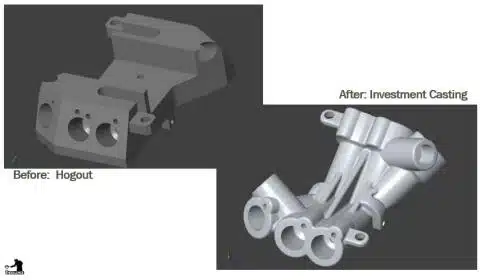
Minor oversights during the design phase of a casting can lead to unintended downstream costs. Let us consider two case studies we have encountered recently as examples of how overlooking the requirements of specifications on your drawing can lead to extraneous manufacturing steps.
The first was a complaint from a Quality Engineer at company that was machining and assembling one of OFC’s castings as a first tier supplier to a medical customer. The complaint was the result of their customer rejection of a group of castings that, for some “mysterious” reason, were marked by a letter “W”. After a few moments research I confirmed that the castings were so marked was because the material specification on the customer drawing required that a letter “W” be marked onto any casting that had been weld reworked. Realizing then that their drawing was the root-cause of the situation the rejection was quickly resolved and OFC given direction from the customer that the marking of welded castings is not required.
The second was our request that an O’Fallon Casting customer change a partmarking method from ink stamp to laser engraving. (Please see more about Laser Marking.) The particular part in question had been being manufactured by OFC for several years in fairly significant volumes and, similar to the previous example, the drawing’s material specification required that OFC to mark their castings with the heat and heat-treat lot numbers. On investigation of our request the customer discovered that their first operation was to remove the subject partmarking. So the result of our inquiry was that the customer was able to eliminate both OFC’s marking of the castings and their removal of it.
In each of these two cases it was later found that the part designers were unaware that they had flowed a partmarking requirement through their drawing’s material specification. (In addition to partmarking, material specifications can sometimes contain other “hidden” requirements for physical property, chemical composition and non-destructive testing that may unnecessarily drive costs.) As a result of good communication both situations were subsequently remedied but the consequence of the designers’ initial misinterpretation was unnecessary labor and administrative costs for their companies.
Once an engineer adds a requirement to a part drawing those who are working downstream from that decision will likely continue to abide by that requirement for the life of the part. Should a requirement be unnecessary or excessive it will forever factor in the cost of that part and to the affordability of the product on which it is employed.
Engineers can help to avoid these unintentional errors if they collaboratively review a casting drawing with a foundry before it becomes finalized. Foundries who are familiar with the requirements of these specification and may offer recommendations to mitigate the cost of any “hidden” requirements.
O’Fallon Casting provides its customers with a free Concurrent Engineering Service. If you would like to have a “second pair of eyes” review your drawing simply contact your O’Fallon Casting Sales Engineer.
